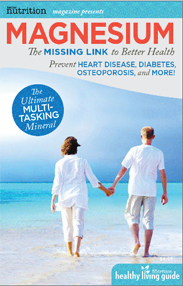Magnesium Supplements Treatment
The Recommended Daily Allowance of magnesium (which is the minimum level needed to stave off deficiency symptoms not the maximum level) varies by age and gender:
Children 1 to 3 years: 80mg, Children 4 to 8 years: 130mg, Children 9 to 13 years: 240mg
Boys 14 to 18: 410mg, Girls 14 to 18: 360mg
Men 19 to 30: 400mg, Men 31 plus: 420mg
Women 19 to 30: 310mg, Women 31 plus: 320mg
Pregnant Women 19 to 30: 350mg, Pregnant Women 31 plus: 360mg
A survey conducted by The Gallup Organization found that 72 percent of adult Americans fall short of the Recommended Dietary Allowance of magnesium.
Because magnesium is required for hundreds of enzymatic reactions (enzymes are protein molecules that stimulate every chemical reaction in the body), deficiency can cause a wide variety of symptoms, such as low energy, fatigue and chronic fatigue, weakness, PMS, menstrual cramps and hormonal imbalance, insomnia, osteopenia, osteoporisis, bone mineral density loss, muscle tension, spasms and cramps, cardiac arrhythmia and cardiovascular disease, headaches and migraine headaches, anxiousness, nervousness and irritability.
Dr. Carolyn Dean, author of “The Magnesium Miracle” states: “The recommended daily allowance (RDA) is about 350mg per day, but most researchers say you need two and three times that amount, partly because it’s not in foods. If it is in foods, if you cook and process the foods in any way, you lose magnesium.
Magnesium Absorption
”Not all forms of magnesium are equally absorbed by the body and according to research, magnesium oxide is only 4% absorbed by the body.
The amount of magnesium your tissues can readily use is based on the amount of elemental or ionic magnesium that is released. There are several organic salt chelates that are highly absorbable such as magnesium citrate, taurate and malate. Two forms to avoid are magnesium aspartate and glutamate. Aspartate breaks down into the neurotransmitter aspartic acid, which without being bound to other amino acids is neurotoxic. Glutamate also breaks down into the neurotransmitter glutamic acid, which without being bound to other amino acids is also neurotoxic. Both are components of aspartame which should also be avoided.
1. Practitioners may have a number of reasons for suggesting a particular supplement brand.
a) Their own research of ingredients, quality and absorbability or assimilation by the body.
b) Reading research studies on a particular product.
c) Individual patient’s profile and body type.
d) Muscle testing or Kinesiology with a particular patient on a variety of supplements – choosing the best for that patient based on these tests.
e) Experience with a particular supplement and/or anecdotal results.
2. Absorbability – You can absolutely tell by the label if the body can absorb a supplement. But there are also additional factors which affect absorption:
a) Are the patient’s intestines healthy or diseased.
b) Availability of protein transport molecules.
c) Availability of parathyroid hormone.
d) The rate of water absorption for water soluble supplements.
e) The amounts of calcium, phosphorus, potassium, sodium and lactose (milk sugar) in the body, all which inhibits certain supplement absorption.
f) Supplemental iron which can impede certain supplement absorption.
g) Yeast toxins, inflammatory substances the body produces as it tries to neutralize those toxins, and undigested food molecules all form barriers to the absorption of dietary an supplemental nutrients.
More on Magnesium Absorption
The mineral Magnesium is necessary for the enzymes that digest supplements and food–if you don’t metabolize your supplements and food properly you don’t get the nutrient benefits from the supplement. And yet over 75% of people have a magnesium deficiency and do not get their RDA of this mineral.
3. Questionable Ingredients – Obviously harmful ingredients such as aspartame which is a neurotoxin, trans fats, artificial colors and flavors are all to be avoided. But there are also fillers that inhibit or slow absorption.
4) Synthetic vitamins: If the brackets after a vitamin have a food listed, it’s natural, if it has a chemical listed, it’s synthetic. Some products have both natural and synthetic vitamin – e.g., fruits and vegetables that supply natural vitamins.
5) Poor formulations: For example you need just as much magnesium as calcium for the best absorption of both.
6) Standardization: Not necessarily. Sometimes it’s the whole herb that has the active component and also the natural components that neutralize any side effects of too much of the active herb.
7) One other factor to be aware of it that often the cheaper the product the cheaper the quality.
8. As we get older we become more deficient in magnesium and therefore require more in our diet and in supplement form. Weight for weight and dollar for dollar, the organic salt chelate in the form of magnesium citrate powder may be the best buy for general use. It is inexpensive and easily absorbed and can be found in most health food stores or vitamin shops.”
Medical Disclaimer:
The ideas, procedures and suggestions contained in this article are not intended as a substitute for consulting with your physician. All matters regarding your physical health require medical supervision. Neither the author nor the publisher shall be liable or responsible for any loss, injury or damage allegedly arising from any information or suggestion in this article. The opinions expressed in this article represent the personal views of the author and not the publisher.
Newsletter
![]()

Want valuable information regarding the health benefits of magnesium, latest studies, expert interviews,videos and health tips? Enter your name and email address and you can start receiving valuable health information right away.
Featured On:








